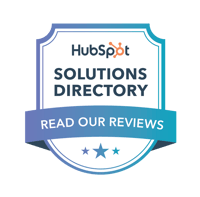Moving requires careful planning, a lot of coordination and a tremendous amount of heavy lifting - this is true whether you're moving to a new home or moving your website to a new platform.
If you're considering making the switch from WordPress to HubSpot, you might be concerned that the migration will harm your SEO. However, if you follow the right steps you can avoid any negative impact to your SEO.
We recommend following these tips from HubSpot to ensure a smooth migration:
Pre-Migration
1. Crawl the existing site
Before you start your migration, it's important to take stock of what pages you have on your site and how they are currently appearing to Google. First, start with a content audit to map out all of the important pages on your site. Next, you'll want to use a website crawler.
A website crawler takes note of all of the URLs on your website and how Google currently processes your information. Performing a crawl will show you all the pages on your website that Google is able to see - this is an important jumping-off point for creating a list of URLs and it can also show you any old pages that are still live that don't need to be on the new site.
Screaming Frog and Semrush are both tools that will allow you to run a website crawl.
2. Record your benchmarks
If your migration goes smoothly, you shouldn't lose any historical data when you transfer your site from WordPress to HubSpot. However, just because it shouldn't happen doesn't mean it can't happen.
If you have any historical benchmarks you don't want to loose, make sure to jot them down. These could be metrics like site visitors, time on page, etc. from a historical period that you use to compare against your current metrics to chart growth.
3. Map your URLs
If you're going to be changing any URLs in the migration or removing pages, it's important to make sure your new and old content is going to line up. If users try to access a page that no longer exists, they'll get a 404 error and your SEO will take a massive hit.
To avoid this, map out all your URLs. You can do this by simply creating a spreadsheet with two columns: one for your current URL and one for the new URL that will take its place. If you're removing a page, choose a page you want to redirect viewers in case they click on a link to the old page.
If you have a lot of pages, HubSpot recommends looking for patterns in your URLs that can be redirected in groups or sections.
4. Make sure you're retaining titles, meta descriptions and HTML
To avoid harming your SEO when migrating from WordPress to HubSpot, make sure you retain all of your backend SEO information.
If you want to change page titles are meta descriptions, ideally that should come down the line after the migration. If it's important to update prior to migration, ensure that the new title and meta are still reflective of the page's content.
5. Try out the new build on a test server
Before you make the move final, run your site on a test server. When transitioning from WordPress to HubSpot, this is fairly easy to do - just keep your HubSpot site offline until you're ready to pull the trigger. Creating a test version of your site with content will allow you to double-check for any missed broken links or other issues.
6. Choose the right date for the migration
No matter how best you plan, you might still run into some issues on the day of migration or discover some issues shortly after migration. Even if you're a business owner or marketing manager and not actually doing the migration yourself, don't pick a date right before you leave on vacation. Also avoid making the transition during peak hours, if possible.
Day of Migration
7. Prepare to update your site's DNS settings
On launch day, you'll need to point your site from WordPress to HubSpot - which is when you'll need to know your site's DNS (domain name system).
DNS is essentially what "translates" your website's domain - like bizzyweb.com - into an IP address that computers can read. Your website host should have all of your DNS information.
8. Launch
Once you're ready to make the switch, set up all your redirects, unpublish your WordPress site and launch your new HubSpot site.
9. Crawl the new site
Now that your new site is live, you'll want to crawl the site again using Screaming Frog or Semrush. Look for any missing pages, anything not properly indexed or other unanticipated errors. If you notice any of these anomalies, you can then update your HubSpot site.
10. Identify and resolve missing and duplicate content
If your crawl turns up any 404s or broken links, take the time to fix them on the new site and ensure all redirects are pointing to the right URLs you identified in Step 3. Take some extra time to poke around the new site as well and make sure there aren't any issues with content.
11. Check for redirect chains
If your old site already had redirects, your migration may have accidentally created redirect chains. For example:
If you were already redirecting A to B, your migration may have added a redirect from B to C.
This creates a chain of redirects: A to B to C.
Redirect chains can majorly slow your site down. You can avoid this by breaking the chains, redirecting A to C and B to C.
12. Ensure Google Analytics and Google Search Console are implemented
If you don't want to avoid any gaps in your data, make sure Google Analytics and Google Search Console are updated once the migrated site is launched. In case of disaster, you'll have your important metrics from Step 2 backed up.
13. Mark the date in Analytics
If you're keeping the same Google Analytics account (which we would recommend), you can set up an annotation to mark a date. Mark the date when you migrated.
This will help you keep track when looking at data, and also help if you bring on a new marketing employee or team in the future that was not around for the migration.
14. Submit sitemaps
Every step up to this point will ensure that your website is running smoothly. The final step is to submit your sitemap to Google so that it can initiate a crawl of your site.
Post-Migration
15. Monitor performance
Once the new site is live, make sure to keep monitoring it for any anomalies or huge dips in traffic. It's perfectly normal to have some decrease in traffic after migration, but if you notice your traffic plummeting this could point to a missing page.
16. Run site audits
Running site audits is a good practice to get into even without migrating a site. Using a tool like Semrush can show you any errors on your site that might be harming your SEO.
17. Update your platforms
Take a look back at any online ads you have running on Facebook, Google or other platforms to update links. While you should have redirects set up, it's always a good idea to point people directly to your new URLs when possible instead of sending them to a redirect.
18. Have publishers update backlinks
If there are other websites linking back to your site, reach out to them with your new URLs. While your redirects shouldn't impact your SEO, it's always better for ranking to have any backlinks pointing directly to your new URLs.
Migrating from WordPress to HubSpot can seem like a daunting process, but following the steps above will ensure a smooth transition without damaging your SEO.
If you don't want to take the risk on your own, reach out to a web design agency that can help you make the move. BizzyWeb is a HubSpot Platinum Solutions Partner with experience in both WordPress and HubSpot.
Strengthen Your SEO with Growth-Driven Design
Instead of front-loading web design with a costly and lengthy new design, GDD treats your website like a living entity and focuses on substantive, impactful updates spread throughout the year.
GDD is data-driven, data-proven, and an overall more effective approach to web design.
BizzyWeb is a Minneapolis-based digital marketing and web design agency that helps companies get the high-quality leads they need to grow and thrive. Our tactics include inbound marketing, SEO, advertising, web design, content creation and sales automation. We are an accredited HubSpot Platinum Partner and we offer full-service HubSpot onboarding, enablement and strategy for new and current users.






